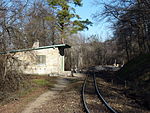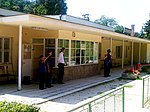Budapest Children's Railway
| Széchenyi-hegyi Gyermekvasút | |||||||||||||||||||||||||||||||||||||||||||||||||||||||||||||||||||||||||||||||||||||||||||||||||||||||||||||
|---|---|---|---|---|---|---|---|---|---|---|---|---|---|---|---|---|---|---|---|---|---|---|---|---|---|---|---|---|---|---|---|---|---|---|---|---|---|---|---|---|---|---|---|---|---|---|---|---|---|---|---|---|---|---|---|---|---|---|---|---|---|---|---|---|---|---|---|---|---|---|---|---|---|---|---|---|---|---|---|---|---|---|---|---|---|---|---|---|---|---|---|---|---|---|---|---|---|---|---|---|---|---|---|---|---|---|---|---|---|
|
Diesel locomotive Mk45-2004
| |||||||||||||||||||||||||||||||||||||||||||||||||||||||||||||||||||||||||||||||||||||||||||||||||||||||||||||
| Course book range : | 7th | ||||||||||||||||||||||||||||||||||||||||||||||||||||||||||||||||||||||||||||||||||||||||||||||||||||||||||||
| Route length: | 11.2 km | ||||||||||||||||||||||||||||||||||||||||||||||||||||||||||||||||||||||||||||||||||||||||||||||||||||||||||||
| Gauge : | 760 mm ( Bosnian gauge ) | ||||||||||||||||||||||||||||||||||||||||||||||||||||||||||||||||||||||||||||||||||||||||||||||||||||||||||||
| Top speed: | 20 km / h | ||||||||||||||||||||||||||||||||||||||||||||||||||||||||||||||||||||||||||||||||||||||||||||||||||||||||||||
|
|||||||||||||||||||||||||||||||||||||||||||||||||||||||||||||||||||||||||||||||||||||||||||||||||||||||||||||
|
Route
| |||||||||||||||||||||||||||||||||||||||||||||||||||||||||||||||||||||||||||||||||||||||||||||||||||||||||||||
The Budapest Children's Railway ( Hungarian : Gyermekvasút ) is an 11.2 kilometer long narrow-gauge railway that was originally built as a pioneer railway ( Úttörővasút ) on Széchenyi Mountain in the west of the Hungarian capital Budapest .
history
The children's railway, built from 1948 to 1950, runs all year round with steam or diesel vehicles on a track width of 760 mm. It is run by children aged 10 to 14; adults only supervise the operation and run the locomotives.
The Budapest Children's Railway describes itself as the largest, most popular and most serious facility of its kind. The 10 to 14-year-old children operate the signal boxes as volunteers , accompany the trains as conductors and are responsible for selling tickets. The model for the railway is the Hungarian state railway MÁV , which also owns the children's railway .
| Route section | opening |
|---|---|
| Széchenyi-hegy– Előre | July 31, 1948 |
| Előre - Ságváriliget | June 24, 1949 |
| Ságváriliget –Hűvösvölgy | 20th August 1950 |
Rail vehicles
First railcars
When it opened on July 31, 1948, there was already a railcar called Kis Piri (The Little Red One ) and two sidecars. The vehicles were in operation in Budapest until 1962 and were then used by the pioneer railway in Dunaújváros until 1976 . In order to cope with the increasing number of passengers, Lillafüredi Állami Erdei Vasút brought another railcar and its sidecars to Budapest, which are still in service. Shortly afterwards, a third train was put into service. The three-axle diesel-electric locomotive M295-5002 of this train and two passenger cars came from Békéscsaba and were operated in Budapest for a year. The diesel locomotive was originally delivered as a gasoline-electric locomotive by Weitzer János Maschinen-, Waggonbau und Eisengießerei in Arad in 1907 to the first field railway Alföld .
Steam locomotives
When the second section of the line went into operation, three oil-fired steam locomotives were purchased from Békéscsaba. They were only partially suitable for the steep mountain route, and the flying sparks posed a forest fire hazard. There were also operational problems, so that they were taken out of service after a year. For the commissioning of the second section of the route, Ganz-MAVAG built and delivered two multiple units and four closed passenger cars. The sidecars are still in regular operation. Models of the railcars with central doors, which were in use until 1973, can be seen in the Children's Railway Museum. From 1958 there were eight four-axle observation cars from Debrecen . One is still operational and is occasionally used, the others were scrapped in 1982. From 1962 to 1963 there were four Mk48 diesel locomotives. The Mk48-2005 comes from Sarospatak , the Mk48-2015 from the Nyíregyháza – Dombrád / Balsa narrow-gauge railway , the Mk48-2038 from the Kecskemét narrow-gauge network . They were called spinach by the children because they were painted green.
Mk49 diesel locomotives
The Wilhelm Pieck Wagon and Machine Factory in Győr built seven Mk49 diesel locomotives in 1932 . The locomotives Mk49-2002, Mk49-2003, Mk49-2005, Mk49-2006 and Mk49-2007 were delivered to Hűvösvölgy and the Mk49-2001 and Mk49-2004 to Sarospatak . After this acquisition, the last railcar from Lillafüred was sent back to Miskolc .
Five large, half-open observation cars and four winter cars with very similar equipment were delivered from Győr in 1963 and are still in use. On November 30, 1970, two Mk49 locomotives were destroyed in a fire in the depot, so that the two locomotives were brought from Sarospatak to Budapest. Because of the incline of the route, there was heavy wear, so that an exchange was necessary. After retirement, the Mk49-2006 was exhibited in Szechenyi-hegy until 2006 and is now being overhauled in the Hűvösvölgy depot. At present (2018), however , a restart is not yet foreseeable.
Mk45 diesel locomotives
In 1973 the Hungarian State Railways MAV bought ten Mk45 diesel locomotives in Romania. Six of them came to Hűvösvölgy (Mk45-2001 to Mk45-2006), four to Sarospatak (Mk45-2007 to Mk45-2010). As a result, the earlier locomotives and railcars were retired. During the liquidation of the Bodrogköz narrow-gauge railway , the Mk45 locomotives from Sarospatak first came to Nyireghazha and from there were brought to Hűvösvölgy in 1994, already inoperable. In the summer of 1991, a historic railcar and four trailer cars were put back into operation in order to expand the children's railway fleet. These authentically reconditioned vehicles reflect the flair of the 1930s.
Passenger cars
In 1928, the Lillafüred State Forest Railway (Lillafüredi Allami Erdei Vasut, LAEV) acquired a 1st class car, two 1st / 2nd class cars, and a 1st class car with a saloon and luggage compartment due to the high volume of passenger traffic. Car for representation trips from Ganz & Partner Danubius Maschinen, Waggon- und Schifffabrik AG (Ganz es Tarsa Danubius Gep-, Waggon- es Hajogyar Rt.) As well as two 2nd class cars and one 2nd class car with luggage compartment, which was identical to that of Ganz & Partner, from the Hungarian narrow-gauge railway factory Orenstein & Koppel (Orenstein es Koppel Magyar Rt. Kskenyvaganyu Vasutak Gyara). The railcars had 66 kW six-cylinder petrol engines and were equipped with a Knorr air brake. They reached a top speed of 30 km / h via a four-speed mechanical transmission. There were 12 seats in 1st class and 28 in 2nd class in compartments that were separated from each other by a sliding door. The middle bench seats could be folded down to allow better access. The large compartments were heated by cooling water. In the sidecar there were 40 places in the transverse and longitudinal direction. There was a wood stove for heating, and the lighting was powered by batteries. There was a toilet in the saloon car and a panoramic window at the end of the car. The multiple unit train started operating in 1929. In the 1940s, Ganz JaR 135 diesel drives were installed in the railcars.
Railcar
The two ultra-modern multiple units were originally put into operation on the LÁEV in Miskolc in 1929 . The guests of the newly opened palace hotel (Palota Szallo) in Lillafüred could take the two luxuriously equipped trains into the picturesque Bükk landscape, but day trippers also used the narrow-gauge railway.
The railcars, which became famous in Hungary, were brought from Lillafüred to Budapest between 1948 and 1949 and were used on the children's railway. The Abamot-2 was in 1951, the Abamot-1 1963 Waldeisenbahn Lillafüred returned.
After returning home, the two cars were already considered obsolete, so that the Abamot-1 was taken out of service in 1977 and scrapped in 1980, the other railcar was in operation in Lillafüred until April 24, 1982 and was then declared worthy of protection. There were considerations to exhibit the existing railcar in Nagycenk, but in the end it was decided to renovate the vehicle.
In 1989 the only remaining railcar and its sidecar were sold to the MÁV and returned to their original condition during a general overhaul. The Abamot 2 railcar received a Raba MAN drive. The car body was painted purple with yellow stripes, white on the windows and light gray on the roof. The already renovated car has been in regular service in Budapest since 1991 as a nostalgic train and is used as a multiple unit for special occasions or for rental.
The small saloon car can be rented for meetings and celebrations. From 1996 the train was used regularly on weekends and holidays as a nostalgic express train during the main season, which only stopped at the terminal stations and in Janoshegy and until 2000 also in Szepjuhazne.
In 1997 the green BDax 41 sidecar was brought to Budapest and then restored on a voluntary basis in the northern vehicle repair shops.
Class 490 steam locomotives
At the end of the 19th century, more and more narrow-gauge rail vehicles were developed due to the increasing volume of traffic. At that time, the MÁV machine factory (MÁV Gépgyár) developed the first narrow-gauge locomotive with four coupled axles and one track with the serial number 70. From 1905 to 1950, a total of 142 locomotives of this type were built initially by the MÁV machine works and later by the MAVAG locomotive works. Apart from a few differences, the boiler and frame were identical when fired with coal or wood.
After the Second World War, only seven locomotives of this type remained in the MÁV fleet. These were used on field railways and mine railways. In the post-war years, production of the Series 70 was resumed. Most were delivered abroad as reparations. Eight Yugoslav locomotives with the numbers 490.054 to 490.061 went to MÁV, one to the Bükk coal power station and one to the Balinka coal mine .
In 1949 three steam locomotives of the 490 type were brought from Békéscsaba to Széchenyi-hegy to the pioneer railway in Budapest for the opening of the second section of the pioneer railway. Since the narrow-gauge railway was not connected to the standard-gauge network, it was difficult to supply them with fuel. As it was difficult to fire them with coal, also because of the slag, they were converted to oil firing in the main workshop in Istvántelek. However, the locomotives did not meet the expectations placed on them. There were often technical malfunctions and the energy consumption was exceptionally high. After the commissioning of the third section of the line, they became superfluous next to the railcars and were therefore transported away, which meant that steam operation on the line ended for the time being.
Six copies of this series are still preserved, including the 490.041 in the courtyard of the MAV Directorate in Szombathely , the 490.057 in Nagycenk and the 490.058 in the Ópusztaszer Memorial Park . The Bugaci kispöfögö with the number 490.053 was used on the narrow-gauge railway from Kecskemét , but came to Budapest for the 50th anniversary of the children's railway. The 490-056 was in Balatonfenyves , but was used less and less because of the poor condition of the line, and has been with the Children's Railway in Budapest since December 25, 2000. This marked the beginning of the second epoch of steam operation for nostalgic trips.
The 490.039 was built in 1942. It was initially used in Marosvásárhely and from 1943 on the local railway from Szatmár to Bikszád . From 1945 it was in operation in Békéscsaba. This steam locomotive came to the pioneer railway in 1949 and was used there together with the 490.044 and 490.049 oil-fired. In 1973 it came back to the Budapest Children's Railway from its interim service on the Szob economic railway, but could not be used as planned for the 25th anniversary. Instead, it was exhibited next to the station building for 30 years. It has now been completely overhauled and has been operational again since June 2007, so that it can also be used in double traction for longer nostalgic trains on special occasions.
Rail vehicles currently ready for use
Locomotives and railcars
- 6 diesel locomotives of the type Mk45 (Mk45.2001 to Mk45.2006)
- 2 steam locomotives of type 490 (490.039 and 490.056)
- 1 LAEV railcar (Abamot 2)
- 1 type C50 diesel locomotive (C50.303)
dare
- 8 winter cars
- 8 open observation cars (summer cars)
- 1 bicycle transport trolley
- 1 laboratory trolley
- 2 open-plan saloon cars
- 1 small open observation car
- 3 blue historical sidecars for railcars
- 1 small blue historic saloon car
- 1 green historic mail car
- 1 green open historic car
- 14 freight cars
Operating points
| Operating office | image | description |
|
|---|---|---|---|
| Széchenyi-hegy |  |
The station ( állomás ) Széchenyi-hegy ( Széchenyi -berg) is the starting point of the children's railway . It has two platform tracks, a separate workshop shed, two sidings and a reception building. The shape signals are operated from two interlockings. |
|
| Normafa mh. |  |
The Normafa stop ( megállóhely ) has been located 800 meters from Széchenyi-hegy since 1973 . Between 1948 and 1973 it was 400 meters further in the direction of Csillebérc, but was relocated because the platform was outside the curve and so difficult to see; the new location was also closer to the Hotel Olimpia . |
|
| Csillebérc |  |
Csillebérc, which was Úttörőváros ( pioneer town ) until 1990 , has, like all subway stations at Gyermekvasút, a reception building and two tracks so that train crossings are possible. In addition, at the entrance from the direction of Széchenyi-hegy there is the only technically secured level crossing of the children's railway with flashing St. Andrew's crosses. The station has light signals as entry and exit signals. |
|
| Virágvölgy |  |
Virágvölgy also has a reception building, two tracks and form signals as entry signals, but no exit signals. Until 1990 the station was called Előre ( Forward ). | |
| Janos-hegy |  |
János-hegy has the same structure as Virágvölgy. |
|
| Vadaspark mh. | The Vadaspark stop was opened in 2004 and between 2006 and 2017 only served in summer and on weekends. Since 2018, trains have only stopped by prior notification, for example by hiking groups. | ||
| Szépjuhászné |  |
Szépjuhászné, until 1990 Ságváriliget ( Ságvári Park ), has a reception building with a Dominó 55 type signal box, two tracks and light signals at the entrance and exit. |
|
| Kis-Hárs-hegy mh. | Kis-Hárs-hegy ( Klein-Hárs-hegy ) was a breakpoint halfway between Szépjuhászné and Hárs-hegy. Due to a lack of demand, it was closed again in 1951, but remains can still be seen today. | ||
| Hárs-hegy | This station also has two tracks for train crossings, a reception building and form signals as entry signals. | ||
| Hűvösvölgy |  |
Hűvösvölgy ( Im Kühlental ) is the valley and terminus of the children's railway. It has a central platform on which the station building was built. This contains the signal box, toilets, two ticket offices, a waiting room, a museum on the Úttörő and Gyermekvasút, and a guest room with beds for delegations from other children's railways. The platform can be reached via two tunnels. The shape signals were replaced in April 2017 by light signals, which are controlled by the Dominó 70 interlocking design. |
|
| Hűvösvölgyi fűtőház and vontatási telep |  |
The station is joined by the depot ( vontatási telep ) completed in 1951 and the Hűvösvölgy ( H Bahnvösvölgyi fűtőház ) depot , which has a turntable and a three- tier locomotive shed . |
BKV symbol of Gyermekvasút
Cinematic reception
The Hungarian film director Klára Trencsényi made the award-winning documentary Reményvasút , which portrays the lives of three adolescents who work for the Budapest Children's Railway , as well as their family and social environment.
Web links
- Website of the children's railway (Hungarian)
Individual evidence
- ↑ a b c d e Laminated text panels in the Museum of the Children's Railway Budapest
- ↑ Train to Adulthood (Reményvasút). DOK Leipzig, accessed on February 5, 2019 .
Remarks
- ↑ Even on the Gyermekvasút website, different dates are given for the existence of the barrier post (abandonment 1979 or 1980). Other sources say 1958 to 1979 or 1966 to 1979. The stop light system was probably built in the winter of 1979/1980; In the film “A mosoly vonata” from 1957, the old stop light system is still in operation on the control panel, but the train can also be seen in a right-hand bend past a crossing with a full barrier, which would only apply to this crossing in this direction of travel. A train in the opposite direction may also have been picked up, then it could also apply to WÜ Távcső utca, which accordingly also had a full barrier.
Coordinates: 47 ° 29 ′ 39 ″ N , 18 ° 58 ′ 36 ″ E











